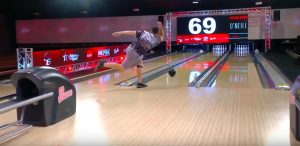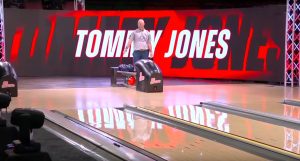PBA Tour Rolls Back Into Action With New ‘Strike Derby’ Format on Fox
Tournament targets mainstream-sports fans as well as bowling buffs
Story Highlights
Live bowling returned to television last Saturday with the first-ever PBA Strike Derby on Fox. Designed to satisfy the appetite of content-hungry sports fans, the home-run–derby–style tournament not only marked the return of PBA Tour action, which was halted on March 15 due to the coronavirus pandemic, but also was the debut of a tournament format targeting the bowling fan and mainstream-sports fan alike.
“There’s nothing more nerve-wracking than it being your first show back from your postponement and also launching a brand-new format you’ve never done before live — and doing it all on broadcast TV with a bigger audience [than cable],” says PBA CEO Colie Edison. “But we were really happy with the results. Producing live sports is a challenge to begin with, so doing it during a pandemic is beyond challenging. But our entire team really stepped up.”
The event at Bowlero Jupiter in Florida was the first in a series of PBA Tour events that are scheduled for the next two months and will be produced without fans in attendance and plenty of added safety protocols to ensure the health of the players, officials, and TV-production crew.
Inside the Truck: Safety Remains Paramount
The PBA on Fox show was produced out of Lyon Video’s Lyon 8 mobile unit, which rolled in a day earlier than usual for setup and was outfitted with plexiglass panels separating several positions. All Lyon mobile units have new CDC-recommended MERV (Minimum Efficiency Reporting Value) 14 air filters for improved air quality. Crew members, who were all temperature-tested and filled out a waiver on arrival, were reorganized to ensure social distancing and required to wear masks and other PPE inside the truck at all times.
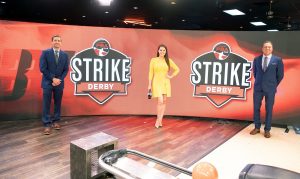
From left: Dave Ryan, Kimberly Pressler, and Randy Pederson maintained social distancing throughout the broadcast.
“It worked out well,” notes PBA on Fox producer David Bruner, “and it did not feel crowded at all. Everyone took it seriously and wore their masks, so we all felt really good about it. Everybody was just excited to be back. It was the first event back for the entire crew since we left the air in March.”
Strike Derby Format: New Kind of Production for New Kind of Bowling
In the PBA Strike Derby format, eight players are given two minutes apiece to record as many strikes as they could using three parallel lanes. Players were then placed into an elimination bracket, with Kris Prather defeating Anthony Simonsen in the finals to take the crown. The high-energy format was not only a viable alternative to traditional PBA Tour title events, which aren’t logistically possible at this time, but also as an effort to appeal to more-mainstream viewers.
“One of the main things we wanted to do was to reach a wider audience than we’ve ever reached before, especially since we were on Fox [broadcast network],” says Edison. “We knew we were speaking to a non-bowling fan more than we typically are, so it was important that we put something forward that can bring more people into the sport. The Strike Derby format enabled us to do that. Plus, we wanted to have a small footprint to abide by social-distancing guidelines. This format lent itself to that.”
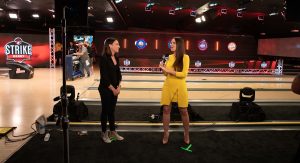
Reporter Kimberly Pressler (right) socially distanced during her interviews, including this one with PBA Tour’s Colie Edison.
Inside Bowlero Jupiter, the production team rolled out its standard camera complement: four hard cams (one super-slo-mo), two handhelds (one super slo-mo), two POVs to cover pin decks, two POVs (low come-and-go shot on lanes), one POV (high overhead), and one POV (foul line)
“When we went three lanes for the Strike Derby, we decided to make the handhelds a lot more active in the cut,” Bruner explains. “Our director [David Newman] was working very hard to make that happen, so it would really pop.”
Several players also were miked and were able to speak directly to PBA Tour on Fox announcers, who were socially distanced inside the venue. Player interviews were conducted from a distance.
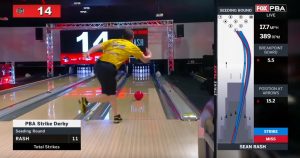
With the new derby format in place, the graphic displayed a tracking line for every single shot, creating a visual similar to the spray chart for a home-run derby.
As a result of the derby format, changes had to be made to the Kegel Specto StrikeTrack ball-tracking analysis technology used for PBA Tour on Fox telecasts. Typically, the StrikeTrack graphic displays the ideal strike lane for a player and compares it with the live shot. However, with the new derby format, the graphic displayed a tracking line for every single shot, creating a visual similar to the spray chart for a home-run derby.
“A regular show is much slower, and there’s more time taken to make a shot,” says PBA Tour Commissioner Tom Clark. “We will determine the ideal strike line for a player and then compare the live shot to it. The players on the PBA tour are so precise that you can see the line just completely cover the ideal line.
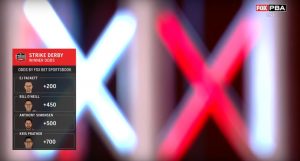
Several money line graphics were integrated into the telecast to help promote the PBA’s new partnership with Fox Bet.
“But for this event,” he continues, “when they’re going so fast and they don’t have as much time to be as precise, we decided to leave every single shot in the [the graphic], which still showed the incredible consistency of the player.”
The Strike Derby also marked the PBA Tour’s first integration with Fox Bet. The online sportsbook enables residents of New Jersey, Pennsylvania, and Colorado to legally bet on the event. Several money-line graphics were integrated into the telecast to help promote the partnership.
No Crowd, No Problem
In lieu of a crowd in Jupiter, PBA rolled out a giant curved LED wall in an effort to replace the energy and ambiance created by fans. However, Edison notes, unlike many other leagues, PBA’s business model and broadcast experience aren’t reliant on fans in the stands.
“The in-area audience has never been a key factor for us,” she notes. “It’s a nice-to-have vs. a need-to-have like it is for the NFL, NBA, or MLB experiences. [Not having] an audience doesn’t drastically change the experience for us. And, from a commercial standpoint, in-stadium fans are not part of our business model. [Other leagues] need butts in seats in order to meet their revenue goals, but we don’t. So it was easier for us to return.”
Prior to the start of the PBA Strike Derby, the production team also recorded a PBA Summer Clash telecast that will air on Fox this Saturday at 6 p.m. ET. Next up in July will be a four-night live PBA King of the Lanes series on FS1, with dates to be announced. Although regularly scheduled PBA Tour events are being rescheduled for the fall and winter, Edison says PBA will stay busy throughout the summer.
“Americans are hungry for live sports,” she explains. “To be able to provide that has been an amazing opportunity. We’re very happy to be filling that void for people.”
